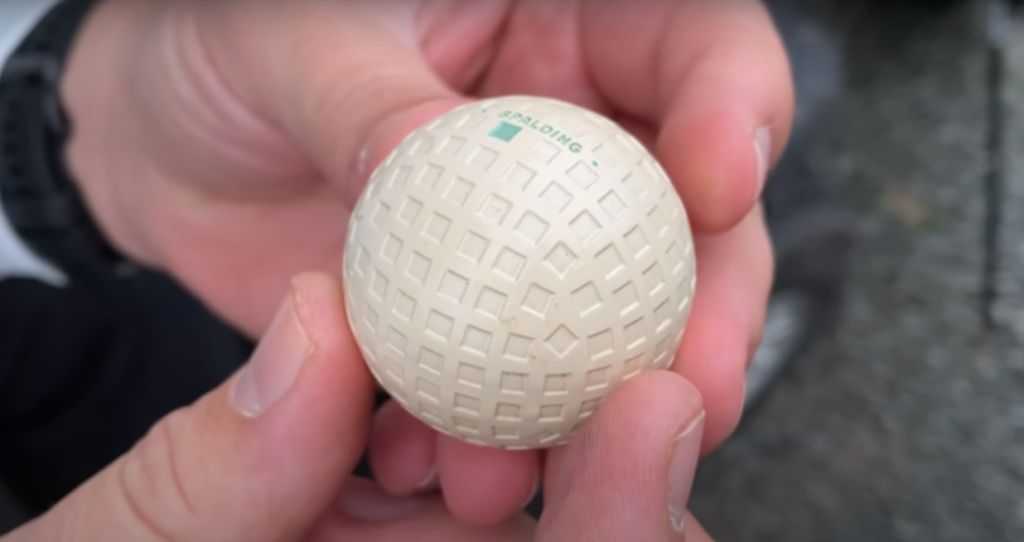Golf balls are fascinating orbs with some amazing properties. So, have you ever wondered what happens when you drop a golf ball into the water? How do these dimpled spheres interact when dropped in a bucket of water? Does a golf ball sink or float in freshwater or saltwater? Will it sink like a stone or does it bob on the surface of the ocean? Let’s learn more about the golf balls that sink and floating golf balls in this Golfing Gimmicks article. We’ll explain the density of a golf ball and many other characteristics associated with these curious little spheres.

Floating Golf Balls Vs Regular Golf Balls
Does a golf ball sink or float normally? Well, normal golf balls don’t float in the water. The primary difference between floating golf balls and their conventional counterparts lies in their design; floating golf balls feature less dense construction that enables them to float on water hazards or while playing golf near water features. So, even though they might appear the same, they’re very different in many aspects, why does a golf ball sink or float in water? Let’s answer this question by comparing golf balls that float with the ones that don’t.
Core
Floating golf balls are designed to stay afloat after landing in water. They have an inner core made of lightweight materials, such as foam or cork, that trap air and give them buoyancy. However, regular golf balls are made of rubber or synthetic materials. This explains the query, “How does a golf ball sink or float in water?”
Material
Golf balls that float are made of unsinkable materials. The outer cover of floating golf balls is often made of a soft and durable material to help prevent water absorption, maintaining their buoyancy over time. Standard golf balls, on the other hand, are composed of durable materials like urethane or Surlyn. So, they sink in water.
Usage
Does a golf ball sink or float? Well, floating golf balls are typically used on courses with water hazards. They are ideal for golfers who want to practice hitting shots over water without losing their balls. But normal golf balls are the standard choice for golfers on most courses. Now, you can understand why some balls sink while others float.
Technology Behind Floating Golf Balls
So, why does a golf ball sink or float in water? Well, floating golf balls are designed to remain buoyant when dropped on water surfaces, defying conventional wisdom that says all golf balls should sink when encountered by water hazards on golf courses. Their construction employs special materials and technology that enable them to remain buoyant despite encountering any water hazards during gameplay. They typically contain core materials that provide enough buoyancy to remain floating even during tough water hazards on courses. We hope now you can understand the physics behind the query, “Does a golf ball sink or float?” The science behind these floating marvels lies within their core materials; manufacturers have created proprietary blends that offer the ideal balance of weight and buoyancy, often enclosed within an outer durable shell for the familiar feel of a traditional golf ball. So, why do golf balls that float act like that? Well, let’s discuss the phenomenon of buoyancy in depth.
Understanding Buoyancy
To fully grasp how floating golf balls stay afloat on water surfaces, we must study buoyancy science. Archimedes first discovered buoyancy principles which come into play here. So, as per the famous Archimedes’ Principle, an object immersed in fluid experiences an upward buoyant force equal to its displacement weight; for this reason, floater golf balls must displace enough liquid to remain buoyant under their weight and thereby stay afloat.
Density
It’s all about the weight and density of a golf ball. So, why does a golf ball sink or float? It takes place due to density. If you want your golf ball to float on the surface of a pool, choose materials with lower density. Let’s discuss how low or high density affects a golf ball’s buoyancy.
High-Density Golf Balls
Due to their compact and heavy design, high-density balls tend to sink. Therefore, professional tournaments frequently utilize them with an emphasis on control and distance control. However, these balls can be a hazard when they sink to the bottom of a riverine, getting waterlogged and eventually unfit for playing. So, why does a golf ball sink or float? The density is to blame!
Low-Density Golf Balls
These low-density balls, constructed using materials that promote buoyancy, tend to float more readily. That’s why they’re perfect for casual play and beginners looking for their first golfing experiences. These are often chosen over higher-density balls as they don’t sink to the floor of a lake. You can buy A99 floating golf balls on Amazon (i.e. floaters) for your convenience.

Composition of Golf Balls
Why does a golf ball sink or float? To understand why certain golf balls float while others sink, examining their construction is vital. Golf balls typically come in two main designs i.e., two-piece and multi-layered. We will explore these differences and how they impact buoyancy.
Two-Piece Golf Balls
Two-piece golf balls feature a solid rubber core encased by an impenetrable cover material for maximum distance potential and distinctive buoyancy characteristics. This design makes two-piece balls known for their distance capabilities and offers unique buoyancy properties when hitting long shots. This explains the question, “Does a golf ball sink or float?”
Multi-Layer Golf Balls
Multi-layer golf balls feature an intricate structure containing various layers like core, mantle, and cover that may impact how they behave when exposed to liquid. These layers may alter how a golf ball behaves when in contact with water. Understand the construction of golf balls to determine whether they’ll sink or float in water.
Material Composition
Golf ball materials play a critical part in defining their density. We will explore all the common materials found within golf balls as they relate to this factor and its consequences on density levels. So, how does a golf ball sink or float in water? It’s determined by the material that the ball is made of.
Core Materials
Golf balls typically use rubber or synthetic core materials with differing densities as their core, impacting their overall density.
Cover Materials
Golf ball covers can be composed of various materials such as urethane and Surlyn; these have different densities which affect their overall density.
Influence of Compression
Compression plays an integral part in golf ball density. You gotta examine how its compression rating influences playability as well as density relationships.

Conclusion
So, why does a golf ball sink or float when dropped in a glass of water? Why do we see floating golf balls and some golf balls that float instead of sinking like a rock? Well, it all depends on the density of a golf ball in the end. You need to revisit Archimedes’ Principle to understand why a golf ball sinks or floats in water. In short, objects with higher density don’t float. Typically, regular golf balls are denser than freshwater so they don’t float; they can float in saltwater as the water in this case becomes denser than our dimpled spheres. That’s because, as Archimedes showed over 2,000 years ago, an object needs to displace a volume of fluid with a weight equal to its own to remain afloat. We hope you understand the physics behind floating golf balls now.
FAQs – Does A Golf Ball Sink Or Float?
Will a golf ball sink or float?
A standard golf ball typically sinks. That’s because the density of a golf ball is approximately 1.6 to 1.8 g/cm³, while the water’s density is 1 g/cm³.
How long does a golf ball sink or float?
This depends on its density, the conditions of its environment, and the materials used during construction.
Do normal golf balls float in saltwater?
Golf balls may float in saltwater due to their lower density compared to freshwater. Similarly, golf balls can float in the ocean, primarily due to their buoyant properties.
What is the density of an average golf ball?
As explained above, the density of a golf ball is around 1.6 to 1.8 grams per cubic centimeter (g/cm³). This explains why we can have floating golf balls. We hope you understand, “Does a golf ball sink or float?”
Q5: Do golf balls float in the ocean too?
Golf balls that have been designed with buoyancy properties should float freely on any body of water including the ocean. Also, it can take them from a century to a millennium to decompose in the ocean. So, avoid hitting golf balls in the sea, please.











